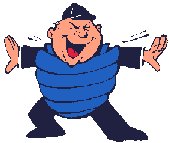© 2019

THE DUGOUT
TEMPLATE PAGE
“Tri-County Umpire Group”
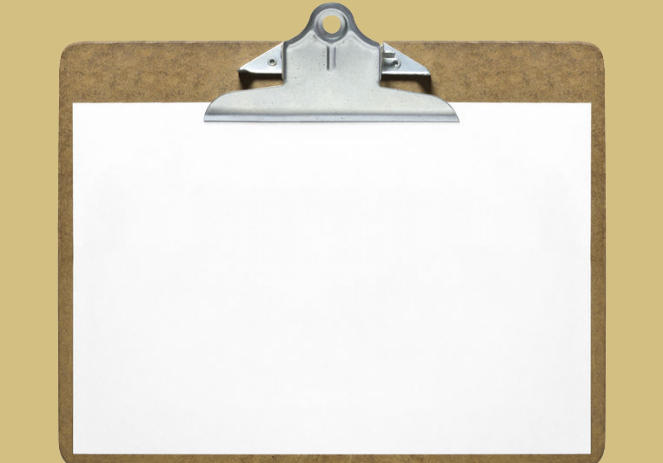
NEWS
2019 Baseball Season is Over
Our 2020 Meeting Dates will be posted soon.
![RE-ENTRY RULE AND 2017 RULE CHANGES FOR LITTLE LEAGUE 7.08 Runner Out Official Rules Little League Any runner is out when - (a) (1) running more than three feet away from his/ her baseline to avoid being tagged, unless such action is to avoid interference with a fielder fielding a batted ball. A runner's baseline is established when the tag attempt occurs and is a straight line from the runner to the base to which he/ she is attempting to reach; or (2) after touching first base, the runner leaves the baseline, obviously abandoning all effort to touch the next base; or (3) the runner does not slide or attempt to get around a fielder who has the ball and is waiting to make the tag; or A.R.- There is no "must slide rule." (4) Little League (Major) and below only: the runner slides head first while advancing. (b) intentionally interferes with a thrown ball; or hinders a fielder attempting to make a play on a batted ball (NOTE: A runner who is adjudged to have hindered a fielder who is attempting to make a play on a batted ball is out whether it was intentional or not); Keep One Foot In Batter’s Box Starting in 2017, local leagues will have the option to mandate batters keep one foot in the batter’s box throughout their at-bat, barring eight exceptions provided in the rule book, during regular season games. If the batter leaves the batter’s box or delays play and none of the exceptions apply, the umpire shall warn the batter. After one warning on a batter, the umpire shall call a strike. Any number of strikes can be called on each batter. During tournament play, the rule is no longer an option and all batters will be mandated to keep one foot in the batter’s box throughout their at-bat, barring the eight exceptions provided in the rule book. Intentional Walk [Baseball Only] For Minor and Major Divisions of Baseball, defensive teams will now be able to elect to intentionally walk a batter by announcing the decision to the plate umpire. After appropriate notification is made by the defensive manager, the ball is ruled dead and no other runners may advance unless forced by the batter’s award of first base. Once the award is granted, four pitches will be added to the defensive pitcher’s official pitch count. Special Pinch Runner Rules During tournament play starting in 2017, a team may utilize a player who is not in the batting order as a special pinch-runner for any offensive player twice a game, but not more than one time per inning. A player may only be removed for a special pinch-runner one time during a game. The player for whom the pinch-runner runs is not subject to removal from the lineup. If the pinch-runner remains in the game as a substitute defensive or offensive player, the player may not be used again as a pinch-runner while in the batting order. However, if removed for another substitute that player or any player not in the line-up, is again eligible to be used as a pinch-runner. Along with the efforts for increased pace of play, additional rules and regulations were created to help promote sportsmanship within the Little League program: Stealing and Relaying of Pitch Selection and Location Starting in 2017, local league umpires will have the option to adopt the rule that the stealing and relaying of signs to alert the batter of pitch selection and/or location is unsportsmanlike behavior. If, in the judgment of the umpire, this behavior is occurring, both the player and the manager may be ejected from the game. The same rule will be mandated during tournament play. 2012 RULE CHANGES FOR LITTLE LEAGUE Rule 6.05(b) in the Baseball Rule Book has been amended to read: 6.05 - A batter is out when - (b) Little League (Majors)/Junior/Senior/Big League – (1) a third strike is legally caught by the catcher; (2) a third strike is not caught by the catcher when first base is occupied before two are out. Minor League and Tee Ball: A third strike is caught or not caught by the catcher. Option: A local league may elect to apply the Minor League and Tee Ball rule for the Little League (Major Division) for the regular season. Summary and Implementation: During the 2012 season, for the Major Baseball Division, players may advance on a third strike that is not caught in flight by the catcher. However, local leagues may opt to use the Minor League and Tee Ball rule noted above, for the Major Baseball Division, instead. This option applies only for the regular season. In Tournament play, the rule will be implemented as noted above for the Majors Division. The rule for tournament play in 10-11 is noted below.](011820_htm_files/1382.png)
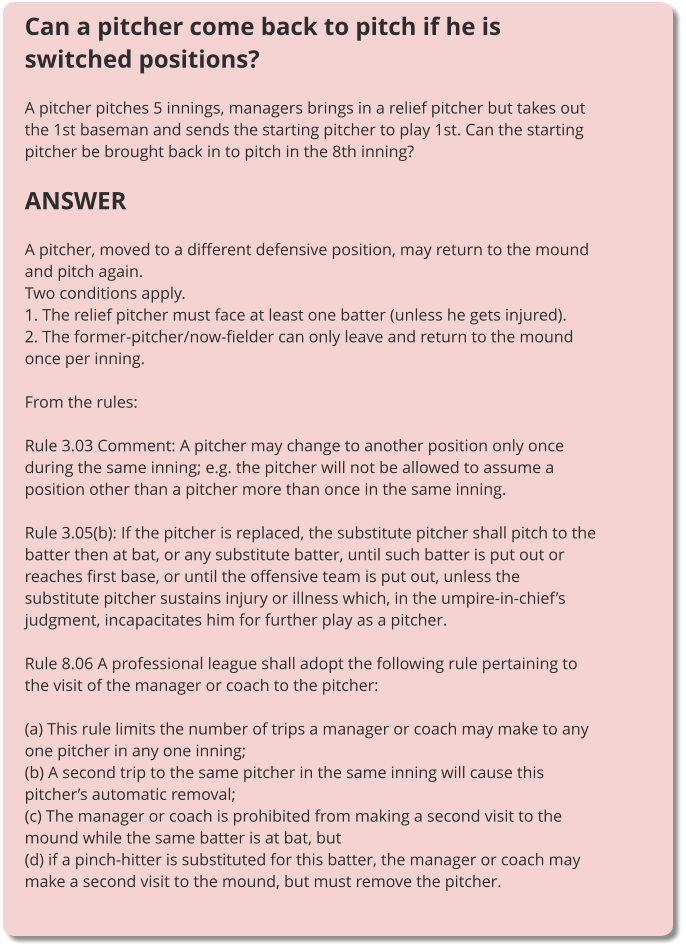
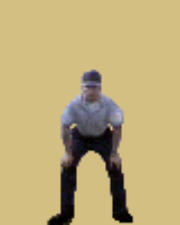


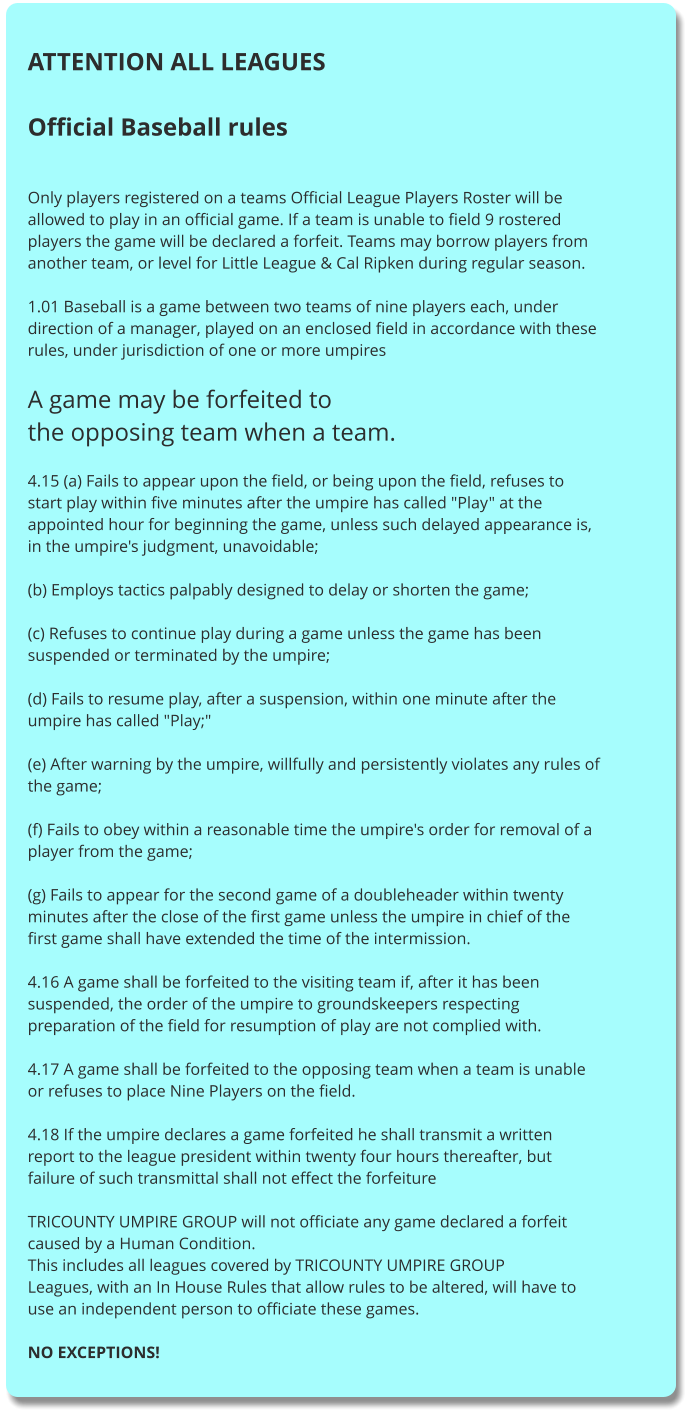
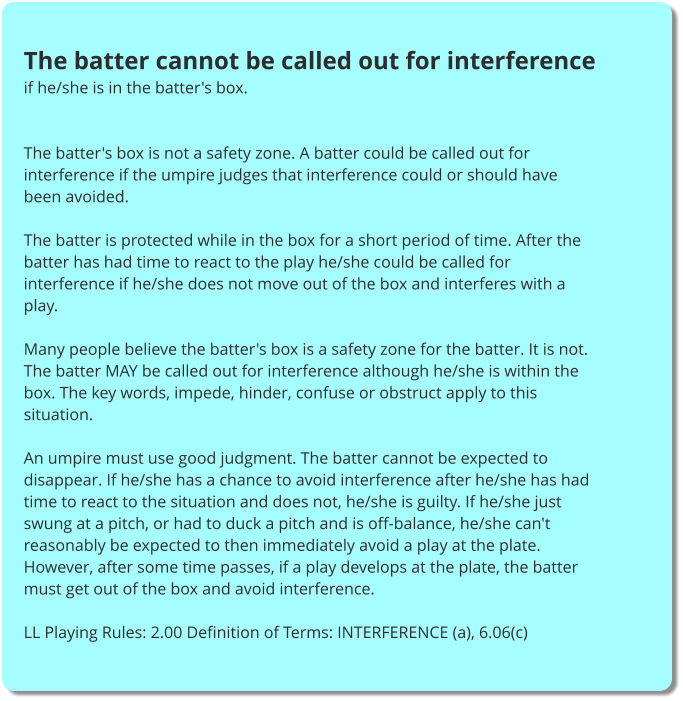
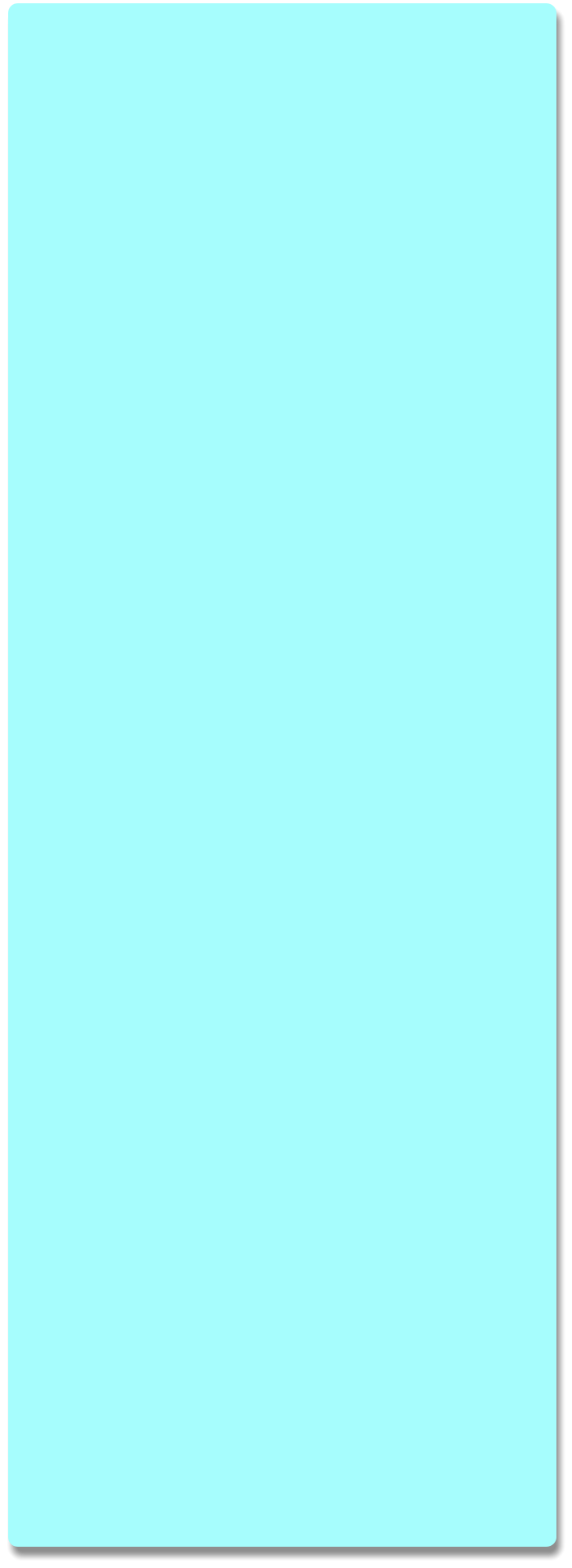
6.05 A batter is out when
-- (a) His fair or foul fly ball (other than a foul tip) is legally caught by a fielder;
Rule 6.05(a) Comment: A fielder may reach into, but not step into, a dugout
to make a catch, and if he holds the ball, the catch shall be allowed. A fielder,
in order to make a catch on a foul ball nearing a dugout or other out-of-play
area (such as the stands), must have one or both feet on or over the playing
surface (including the lip of the dugout) and neither foot on the ground
inside the dugout or in any other out-of-play area. Ball is in play, unless the
fielder, after making a legal catch, falls into a dugout or other out-of-play
area, in which case the ball is dead. Status of runners shall be as described in
Rule 7.04(c) Comment.
(b) A third strike is legally caught by the catcher; Rule 6.05(b) Comment:
"Legally caught" means in the catcher's glove before the ball touches the
ground. It is not legal if the ball lodges in his clothing or paraphernalia; or if it
touches the umpire and is caught by the catcher on the rebound. If a foul-tip
first strikes the catcher's glove and then goes on through and is caught by
both hands against his body or protector, before the ball touches the
ground, it is a strike, and if third strike, batter is out. If smothered against his
body or protector, it is a catch provided the ball struck the catcher's glove or
hand first.
(c) A third strike is not caught by the catcher when first base is occupied
before two are out;
(d) He bunts foul on third strike;
(e) An Infield Fly is declared;
(f) He attempts to hit a third strike and the ball touches him;
(g) His fair ball touches him before touching a fielder;
(h) After hitting or bunting a fair ball, his bat hits the ball a second time in fair
territory. The ball is dead and no runners may advance. If the batter-runner
drops his bat and the ball rolls against the bat in fair territory and, in the
umpire's judgment, there was no intention to interfere with the course of the
ball, the ball is alive and in play; Rule 6.05(h) Comment: If a bat breaks and
part of it is in fair territory and is hit by a batted ball or part of it hits a runner
or fielder, play shall continue and no interference be called. If batted ball hits
part of broken bat in foul territory, it is a foul ball.
If a whole bat is thrown into fair territory and interferes with a defensive
player attempting to make a play, interference shall be called, whether
intentional or not. In cases where the batting helmet is accidentally hit with a
batted or thrown ball, the ball remains in play the same as if it has not hit the
helmet. If a batted ball strikes a batting helmet or any other object foreign to
the natural ground while on foul territory, it is a foul ball and the ball is dead.
If, in the umpire's judgment, there is intent on the part of a baserunner to
interfere with a batted or thrown ball by dropping the helmet or throwing it
at the ball, then the runner would be out, the ball dead and runners would
return to last base legally touched.
(i) After hitting or bunting a foul ball, he intentionally deflects the course of
the ball in any manner while running to first base. The ball is dead and no
runners may advance;
(j) After a third strike or after he hits a fair ball, he or first base is tagged
before he touches first base;
(k) In running the last half of the distance from home base to first base, while
the ball is being fielded to first base, he runs outside (to the right of) the
three-foot line, or inside (to the left of) the foul line, and in the umpire's
judgment in so doing interferes with the fielder taking the throw at first base,
in which case the ball is dead; except that he may run outside (to the right of)
the threefoot line or inside (to the left of) the foul line to avoid a fielder
attempting to field a batted ball; Rule 6.05(k) Comment: The lines marking
the three-foot lane are a part of that lane and a batter- runner is required to
have both feet within the three-foot lane or on the lines marking the lane.
The batter-runner is permitted to exit the three-foot lane by means of a step,
stride, reach or slide in the immediate vicinity of first base for the sole
purpose of touching first base.
(l) An infielder intentionally drops a fair fly ball or line drive, with first, first
and second, first and third, or first, second and third base occupied before
two are out. The ball is dead and runner or runners shall return to their
original base or bases; APPROVED RULING: In this situation, the batter is not
out if the infielder permits the ball to drop untouched to the ground, except
when the Infield Fly rule applies.
(m)A preceding runner shall, in the umpire's judgment, intentionally interfere
with a fielder who is attempting to catch a thrown ball or to throw a ball in an
attempt to complete any play: Rule 6.05(m) Comment: The objective of this
rule is to penalize the offensive team for deliberate, unwarranted,
unsportsmanlike action by the runner in leaving the baseline for the obvious
purpose of crashing the pivot man on a double play, rather than trying to
reach the base. Obviously this is an umpire's judgment play.
(n) With two out, a runner on third base, and two strikes on the batter, the
runner attempts to steal home base on a legal pitch and the ball touches the
runner in the batter's strike zone. The umpire shall call "Strike Three," the
batter is out and the run shall not count; before two are out, the umpire shall
call "Strike Three," the ball is dead, and the run counts.

INTERFERENCE CALLS REFERENCE
-I believe interference is the toughest call an umpire has to make. It is a call
based solely on the umpire's judgment. To make a good judgment as to
whether or not interference occurred, the umpire must understand the
definition as stated in the rules so it can be recognized when it occurs. After
interference is called, the proper rule must be applied.
The definition as stated in Rule 2.00 is:
"(a) Offensive interference is an act by the team at bat which interferes with,
obstructs, impedes, hinders or confuses any fielder attempting to make a
play. If the umpire declares the batter, batter-runner, or a runner out for
interference, all other runners shall return to the last base that was in the
judgment of the umpire, legally touched at the time of the interference,
unless otherwise provided by these rules.
In the event the batter-runner has not reached first base, all runners shall
return to the base last occupied at the time of the pitch.
(b) Defensive interference is an act by a fielder which hinders or prevents a
batter from hitting a pitch."
It should be noted that (b) above is the only defensive interference.
Hindering the runner by the defense is OBSTRUCTION.
How do we interpret this rule? The key, is to focus on the phrase "interferes
with, obstructs, impedes, hinders or confuses." Those words cover a lot of
actions. The umpire, after witnessing an act by the offense must ask himself
the following question; "Did the offense interfere with, obstruct, impede,
hinder or confuse the fielder attempting to make the play?" If the answer is
yes, interference should be called. The call must be made as soon as
possible. When interference is called the ball is immediately dead and no
runners may advance beyond the base they held at the time of the
interference. The umpire must be aware of where all runners are at the time
of the call. When the interference occurs the umpire immediately calls it. You
do not wait to see the outcome of the play.
Some interference calls are easy.
Example: If a runner is hit by a batted ball he is out and no judgment of
intent is required unless he is hit by a deflected ball, or the ball has passed
on infielder, in which case the umpire must decide if he intended to be hit to
interfere, obstruct, impede, hinder or confuse the defense or if another
fielder had a play on the ball. Rule 5.09(f) and 7.08(f).
Example: A runner must avoid a fielder attempting to field a BATTED BALL. If
he does not he is guilty. This is a fairly easy call. Rule 7.09(L) and 7.08(b).
The fielder's protection begins the moment the ball is hit. That protection
continues as he completes his initial play. His protection ends if he misplays
the batted ball and has to move to recover it. Contact with the fielder is not
necessary for interference to be called.
When a ball is hit, you have to judge which fielder has the best chance to
field the ball. That fielder is then "protected" meaning; must not be
interfered with, from the time the ball leaves the bat, up through the gloving
of the ball and the act of throwing. The fielder is protected even if he started
to field the ball from outside the basepath and then moved into it to field the
ball. The runner must avoid a fielder attempting to field a batted ball.
Rule 7.09(L). He must avoid the fielder and not interfere with him during the
entire time that the fielder is in protected status and in all areas including the
basepath.
Rule 7.09(k) In running the last half of the distance from home base to first
base while the ball is being fielded to first base, he runs outside (to the right
of) the three foot line, or inside (to the left of) the foul line and, in the
umpire's judgment, interferes with the fielder taking the throw at first base,
or attempting to field a batted ball; The lines marking the three foot lane are
a part of that "lane" but the interpretation to be made is that a runner is
required to have both feet within the three foot "lane" or on the lines
marking the "lane."
PENALTY FOR INTERFERENCE:
The runner is out and the ball is dead.
Interference is the act of hindering or obstructing a fielder attempting to
make a play. A "Play" is the act of throwing, or attempting a tag of a runner
or a base, or an attempt to catch a throw.
Difficult calls are the ones involving thrown balls. Interference with a thrown
ball must be judged as an intentional act. Rule 7.08(b), 7.09(L). If a runner is
hit by a thrown ball while running the bases, he is not out unless the Umpire
judges that the runner intentionally interfered, obstructed, hindered or
confused the defense attempting to make a play.
Some examples of interference are:
Yelling at a fielder as he attempts a catch or play (Note that the rule states
"the team at bat.." This includes coaches and players on the bench.
Waving his arms to distract the fielder
Making contact with the fielder as he attempts a throw
Making contact or otherwise interfering with the fielder as he attempts to
catch a batted ball
Making INTENTIONAL contact with a fielder as he attempts to catch a thrown
ball. The runner has a right to the base path except when a fielder is
attempting to field a BATTED ball
Making INTENTIONAL contact with a thrown ball
Stopping directly in front of a fielder attempting to field a ground ball

285 School Lane
Springfield, PA 19064
(610) 543-1323
